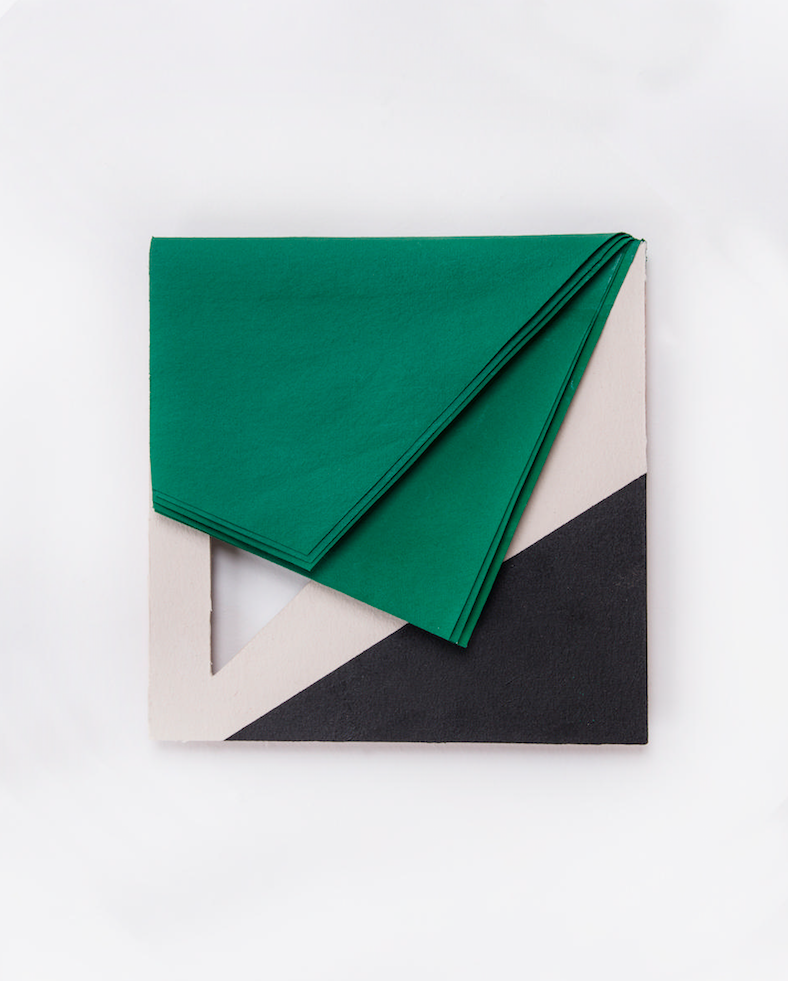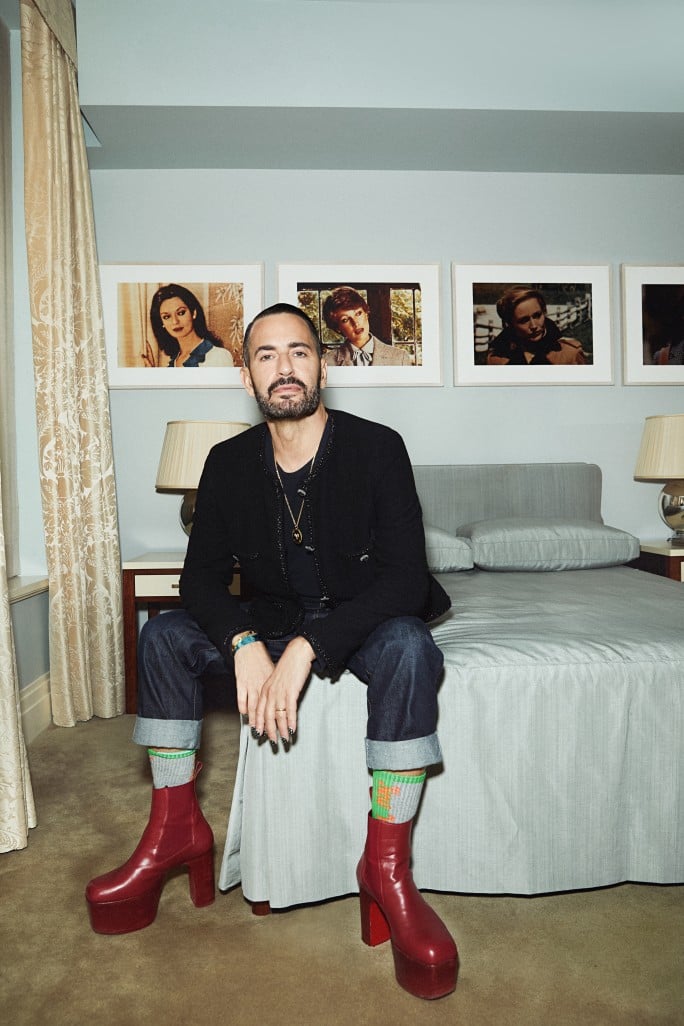
© » KADIST
Aurélien Froment
dbqp is a photographic series in which the artist handles an enlargement of the plate with three cutout windows which was used for L’Archipel (The Archipelago) in collaboration with Pierre Leguillon. The previous work took the form of four photographs presenting a page illustrated with three images. By studying these with more attention, it is possible to figure out that these objects were placed behind the pierced card with three openings.

© » KADIST
Jennifer West
This work was filmed on the shores of Jelly Bowl beach in Carpinteria, California, after Jennifer West was taken by the sight of a coastal family home owned by surfer Andy Perry. After conversing with Perry, spending time in the site, and engaging with several other locals, West wanted to produce a film that documented this idyllic Californian lifestyle and that embodied the sense of joy, warmth and nostalgia that multiple generations of surfers and their families had shared in this site. In the footage we see a couple of silhouettes wrapped up in blankets as they watch their beloved ones surfing at dawn—including surfers Andy Perry, and siblings Makela, Alana and Zach Moore.

© » KADIST
Teppei Kaneuji
In his White Discharge series (2002 to today), arguably his best known works, Kaneuji assembles old toys and plastic scarps into dramatic mounded heaps and covers the surface with white plastic resin, drawing on allusions to landfills, commodity fetishism, and creative repurposing. White Discharge (Built-Up Objects #38) (2014) appears playful, like a lost landscape from a whimsical Dr. Seuss story awaiting a charmingly wacky inhabitant. But in drawing its source materials from prefabricated and mass-produced objects, Kaneuji’s work also suggests more trenchant anxieties consumer culture and the rapid and wasteful accumulation that becomes “built-up” in all of our lives.

© » KADIST
David Haxton
16 films is a selection of David Haxton’s single-screen videos, which he began producing in the 1970s as a continuation of some of the conceptual underpinnings of his earlier film installations. As the described by Haxton, “[he] became interested in in examining the nature of the medium [of film] including light, movement, and the formation of a three-dimensional illusion of space in a flat surface.” This selection of films were produced in 16mm film between 1970 and 1982 and have been digitally mastered in high definition from the original 16mm films, which are preserved by the Academy Film Archive in Los Angeles. Reminiscent of the paired back, low-fi quality of other conceptual video work from that period, Haxton abides to a certain criteria to restrict aspects of the medium: he does not do any editing, always fixes the camera onto a single position for the whole duration of the films, and he limits the actions of the performers.

© » KADIST
Olivia Erlanger
Sideways Time by Olivia Erlanger is the result of the artist’s interest in networks, seen and unseen, financial and ecological, the collapse of which has resulted in the fracturing of a middle class American identity. Consumption and the construction of value are a frequent concern of her sculptures that explore the structural friction between a public and private. Erlanger looks to the architecture that connects these systems for inspiration and in this sense, the language of scaffoldings, foundations and facades that percolate throughout her work.

© » KADIST
Annette Kelm
In Stilleben mid Zierlauch ( Still Life with Aluminum) Annette Kelm utilizes visual juxtaposition to bring together a gridded aluminum backdrop, a pot with a vaguely indigenous pattern on it, and two purple dandelions. The aesthetic dissonance between the mechanical, gridded aluminum and the grainy clay pot signify an interaction between systems of visual production, furthered by the aluminum grid’s inward tilt, visually apparent due to the grid pattern’s convergence at the top of the photograph. Contrasting the stark slant of the grid, the pot sits on a level surface, while the two tall stems protruding from it run at a non-parallel angle to the grid.

© » KADIST
Luciano Figueiredo
Figueiredo’s succinct forms are rendered in bright hues of yellow, red, green, and blue, with white and black defining positive and negative spaces within the overall geometry. His Revelos are part painting, part relief, and part sculpture—they separate from the wall, creating spatial complexities within their bounds, and imply movement through the simplicity of their shapes. Though based on the shape of a simple square, each Revelo animates beyond that limitation, the folded and layered canvas sheets, the cuts and slices of contrasting paints creating movement from stasis.

© » KADIST
Diana Fonseca Quiñones
In Los amantes (The lovers) Diana Fonseca Quiñones uses simple, commonplace objects and experiences that she derives from daily life to develop narratives that mix reality and fiction. Drawing on seemingly everyday moments, such as lighting a match, Quiñones creates poetic metaphors that cleverly comment on broader social issues, as well as politics, and universal human desires. In her profound work Los amantes, the humblest of materials, a pair of burning matches, becomes a parable for the sharing, longing, restraint, and death that everyone faces in life.

© » KADIST
Jedediah Caesar
For Untitled, Caesar encased recycled objects such as scraps of plywood, paper or cloth in resin and then cut and reassembled the pieces into abstract forms. This technical rework allows for a clinical inspection of the material contents of the piece and the resulting slanted industrial monolith echoes minimalist sculpture, although with a different expressive texture. Indeed, Untitled can be seen as a contemporary pyramid with a painterly surface.

© » KADIST
Alexandre da Cunha
His Deck Painting I recalls the simplistic stripes of conceptual artist Daniel Buren, or the minimal lines of twentieth century abstract painting, but is in reality a readymade, fashioned from repurposed fabric of deck chairs. Alexandre da Cunha reinvents found objects in surprising ways that combine the material characteristics of Arte Povera with the concerns and techniques of painting. Da Cunha’s work often features flags—either as a found material per se or as a constructed form—that reflect the artist’s interest in issues of nationality, governmental politics, allegiance, and culture.

© » KADIST
Elad Lassry
In his composition, Chocolate Bars, Eggs, Milk, Lassry’s subjects are mirrored in their surroundings (both figuratively, through the chocolate colored backdrop and the brown frame; and literally, in the milky white, polished surface of the table), as the artist plays with color, shape, and the conventions of representational art both within and outside of the photographic tradition. Elad Lassry explores how visual languages are constructed across multiple disciplines and media. His larger body of work responds to the relationship between artistic mediums and their forms, and his prints question familiar modes of viewership and our continuous desire to find and identify clear narratives in photographs.

© » KADIST
Ed Ruscha
In 1970, Ruscha began a series of paintings made from stains. He experimented with a variety of materials (gun powder, dust, blood, among many others) to leave surface traces of different objects. The resulting images are negative shapes amidst blurry environments like Splinters and Seconal in which a grey surface is imprinted with the materials mentioned in the title.

© » KADIST
N. Dash
Dash shapes, manipulates, and molds the materials herself, as the works becomes something of a physical archive. Through these delicate and time-consuming processes, the artist’s bodily interaction with the material becomes clear, with marks of its making and traces of the artist’s hand embedded in the surface of her quiet compositions.
Jedediah Caesar
- location: Los Angeles, California
- year born: 1973
- gender: male
- nationality: American
- home town: Oakland, California
Ed Ruscha
- location: Los Angeles, California
- year born: 1937
- gender: male
- nationality: American
- home town: Omaha, Nebraska
Jennifer West
Based in Los Angeles, Jennifer West is known for her work with film, not only through creating moving images and photographs, but for her exploration of the materiality of the film itself...
Annette Kelm
- location: Stuttgart, Deutschland
- year born: 1975
- gender: female
- nationality: German
Alexandre da Cunha
- location: London, United Kingdom
- year born: 1969
- gender: male
- nationality: Brazilian
- home town: Rio de Janeiro, Brazil
Teppei Kaneuji
Teppei Kaneuji produces sculptures and installation-based work that interrogates Japan’s continuously burgeoning postwar culture of commodification...
David Haxton
Although trained as a painter, David Haxton is known for his exploration of light through the mediums of photography and film...
Luciano Figueiredo
Brazilian artist Luciano Figueiredo works with color, form, volume, and light in his exquisite wall-bound compositions...
Olivia Erlanger
Olivia Erlanger is a New York based artist that works between sculpture and conceptual art...
N. Dash
- location: New Mexico & New York
- year born: 1980
- gender: female
- nationality: American
- home town: Miami Beach, Florida
-
1970-1979
David Haxton
197016 films is a selection of David Haxton’s single-screen videos, which he began producing in the 1970s as a continuation of some of the conceptual underpinnings of his earlier film installations...
-
2000-2009
Alexandre da Cunha
2005His Deck Painting I recalls the simplistic stripes of conceptual artist Daniel Buren, or the minimal lines of twentieth century abstract painting, but is in reality a readymade, fashioned from repurposed fabric of deck chairs...
Diana Fonseca Quiñones
2007In Los amantes (The lovers) Diana Fonseca Quiñones uses simple, commonplace objects and experiences that she derives from daily life to develop narratives that mix reality and fiction...
Aurélien Froment
2008dbqp is a photographic series in which the artist handles an enlargement of the plate with three cutout windows which was used for L’Archipel (The Archipelago) in collaboration with Pierre Leguillon...
Jedediah Caesar
2009For Untitled, Caesar encased recycled objects such as scraps of plywood, paper or cloth in resin and then cut and reassembled the pieces into abstract forms...
-
2010-2019
Jennifer West
2011This work was filmed on the shores of Jelly Bowl beach in Carpinteria, California, after Jennifer West was taken by the sight of a coastal family home owned by surfer Andy Perry...
Elad Lassry
2013In his composition, Chocolate Bars, Eggs, Milk, Lassry’s subjects are mirrored in their surroundings (both figuratively, through the chocolate colored backdrop and the brown frame; and literally, in the milky white, polished surface of the table), as the artist plays with color, shape, and the conventions of representational art both within and outside of the photographic tradition...
Teppei Kaneuji
2014In his White Discharge series (2002 to today), arguably his best known works, Kaneuji assembles old toys and plastic scarps into dramatic mounded heaps and covers the surface with white plastic resin, drawing on allusions to landfills, commodity fetishism, and creative repurposing...
Annette Kelm
2014In Stilleben mid Zierlauch ( Still Life with Aluminum) Annette Kelm utilizes visual juxtaposition to bring together a gridded aluminum backdrop, a pot with a vaguely indigenous pattern on it, and two purple dandelions...
Luciano Figueiredo
2015Figueiredo’s succinct forms are rendered in bright hues of yellow, red, green, and blue, with white and black defining positive and negative spaces within the overall geometry...
Olivia Erlanger
2016Sideways Time by Olivia Erlanger is the result of the artist’s interest in networks, seen and unseen, financial and ecological, the collapse of which has resulted in the fracturing of a middle class American identity...





